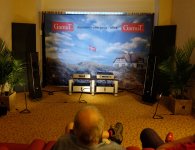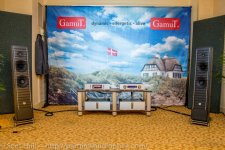Reading posts like this brings back memories. It was almost 2 years ago when Jock (The Professor) and myself purchased Raidho D1's at the same time. We were the first in the U.S. The proverbial guinea pigs. There was very little information on the web about the "C" series on the internet other than a few users in Asia who were very happy with them. There was nothing on the D series of course. Bob (Vintage Tube) as many will remember had purchased the Raidho C3.1's before the D series was announced. I attempted to reach Bob, but he has become quite the recluse after an incident on another forum. I spoke with his dealer, John at Audio Salon, and John said Bob continues to be very happy with his C3.1's. So, I went ahead and purchased the Raidho D1's from John in Miami. John tried to help, but he too was unfamiliar with the D series. So, Jock and I were left to struggle through the same things many of your are experiencing on our own.
Our problems became exacerbated when we both, once again, at the same time, purchased D3's (version 1). I can still remember to this day, getting them home, unpacking them with an audiophile friend, setting them up where I had the D1's, and sat there and listened to what can only be described as bad. The bloated bass, the stiff new drivers, combined with my challenging room, quickly turned my smile upside down. To use a line from Michael Kim, it sounded like I had 10 cheap subwoofers in the room. Jock too was experiencing similar challenges. But as we piled on the hours (we were hopeful that 500 hours was the magic number!

), we could hear the Raidho magic creeping through. We were determined. We worked together. Emailing. Texting. Talking. He was thinking up new ideas to tame the bass, I was constantly reaching out to Lars and Michael who were quite helpful, but many of their suggestions ultimately failed. I tried granite, cables, electrical grounding, mechanical grounding, whatever was suggested or any ideas Jock and I drummed up.
If any of you have bothered to watch the Room Acoustic video Myles posted the other day, you will note how the expert says listening in the near field reduces the speaker/room interaction (which is obvious). I tried listening in the near field, long wall, short wall, normal listening position,etc., and in my main room, the result was always the same. As a side note, I observed those who visited my listening room while I had the D3's and noted how most were VERY uncomfortable listening near field. Many would get up and walk and stand several feet behind the chair. They simply hated listening in near field. One guy said, "by the way those drivers are vibrating and popping, I think they are going to fly out and hit me in the head." Eventually, I just gave up and sold the D3 v1's.
I returned to Raidho with the launch of the D3 v2. This time around, I had better success. I tried the D3 v2 in my main room, but the bass wasn't much better. When I moved them into my rather large great room (45' x 15' x 13' ceilings), powered them with the VAC phi200's, I had finally got them. Bass problems were gone. The magic was there. I eventually sold them (as us gear swappers do), and I will say, I do honestly miss their 3D/holographic magic. I would love to own the D5's one day, but its unlikely to happen any time soon give the space requirements. I was going to go with D5's, but after seeing them and asking questions about their space requirements, I thought it best to hold off.
So, the point is, I know what all of you are going through. You can hear the magic. You can hear the potential. You want them to work sooooo badly. I will tell you it IS possible. I was able to get them to perfection - but it took a room where essentially the room wasn't in the equation. It took the right amps (VAC phi200's). It took weeks of experimenting with setup to get things dialed in just right. And yes, in the end, the gear swapping bug hit, I blew it all up and moved on.
When I spoke with Lars at RMAF, he showed me the treatments they are working on (of course, the cynic in me did think "are they selling me a problem only so they can sell me a solution?"). From what I heard, I think these treatments are well worth exploring.
I chuckled when I started to read about the DSP discussion and Raidho's. I thought to myself "yup, been there, done that too". When I had the Raidho D3 v1's, I tried the McIntosh MEN 220, DSPeaker 2.0, DEQX and several other DSP products. Yup, they worked, the boomy bass was fixed, but guess what? The magic was gone too.
Good luck -
I really do hope you reach Raidho nirvana.


